Facebook Ads retargeting is one of the most powerful yet underutilized strategies in digital marketing today. It allows brands to show personalized ads to people who have already interacted with their content, website, or app. These users are considered “warm” leads—they’ve shown intent, and retargeting is your opportunity to bring them back and convert them.
If you’re only targeting cold audiences, you’re leaving money on the table.
In this post, you’ll learn everything you need to know about Facebook Ads retargeting in 2025: how it works, how to set it up, what types of retargeting campaigns to run, budget tips, best practices, and real-world case studies with results.
What Is Facebook Ads Retargeting?
Facebook Ads retargeting (also called Facebook remarketing) is a tactic that targets users who have already interacted with your brand—whether through your website, social content, video views, lead forms, or purchases—and shows them highly relevant ads to bring them back into your funnel.
Facebook does this using tools like the Meta Pixel, Conversions API, and Custom Audiences. These tools allow advertisers to track behaviors, build segments through audience segmentation, and retarget people across Meta’s platforms (Facebook, Instagram, Messenger, etc.).
Key Facebook Retargeting Ads Triggers:
- Website visits (via Meta Pixel or Conversions API): Tracks site visitors who have visited specific URLs on your website so you can retarget them with tailored messages based on their behavior.
- Video views: Captures users who watched part or all of your videos on Facebook or Instagram, indicating interest in your brand or content.
- Facebook/Instagram page engagement: Targets users who have liked, commented, shared, or clicked on posts from your business page or Instagram profile. These users are likely fans of your brand.
- Facebook/Instagram ad engagement: Allows you to retarget those who have interacted with previous ads, such as clicking a link, reacting, or watching a video.
- Shopping cart abandonment: Reaches people who added products to their cart but didn’t complete the checkout process.
- In-app activity: Focuses on users who have installed and interacted with your mobile app, such as browsing or searching for items on their screen.
- Customer email or phone lists: Uses your existing CRM, email, list of contacts or customer list to retarget known users by uploading their user IDs.
- Event interest or attendance: Lets you reconnect with people who showed interest in or RSVP’d to an event you promoted through Facebook Business Manager.
Why Retargeting Matters: The ROI Multiplier
Retargeting works because it focuses on people who already know you. They’re more likely to convert than brand-new visitors.
Retargeting doesn’t just bring people back—it creates more efficient ad funnels, boosts ROAS (return on ad spend), and reduces cost per acquisition. It also gives Shopify sellers and small businesses a competitive edge in a crowded market.
Further Reading: Are Facebook Ads Still Worth It in 2025? A Comprehensive Analysis
How Facebook Retargeting Works
Before you can launch an effective Facebook retargeting campaign, it’s crucial to understand how the process works behind the scenes.
In simple terms, retargeting works by using tracking tools like the Meta Pixel (or the newer Conversions API, known as CAPI) to monitor your website visitors’ actions. Once someone lands on your site and takes an action — like viewing a product, adding to cart, or signing up for a free trial — that data is sent back to Facebook.
From there, Facebook builds what’s called a Custom Audience, grouping together people who have shown interest in your business. You can then show this audience highly relevant ads to remind them to come back and convert.
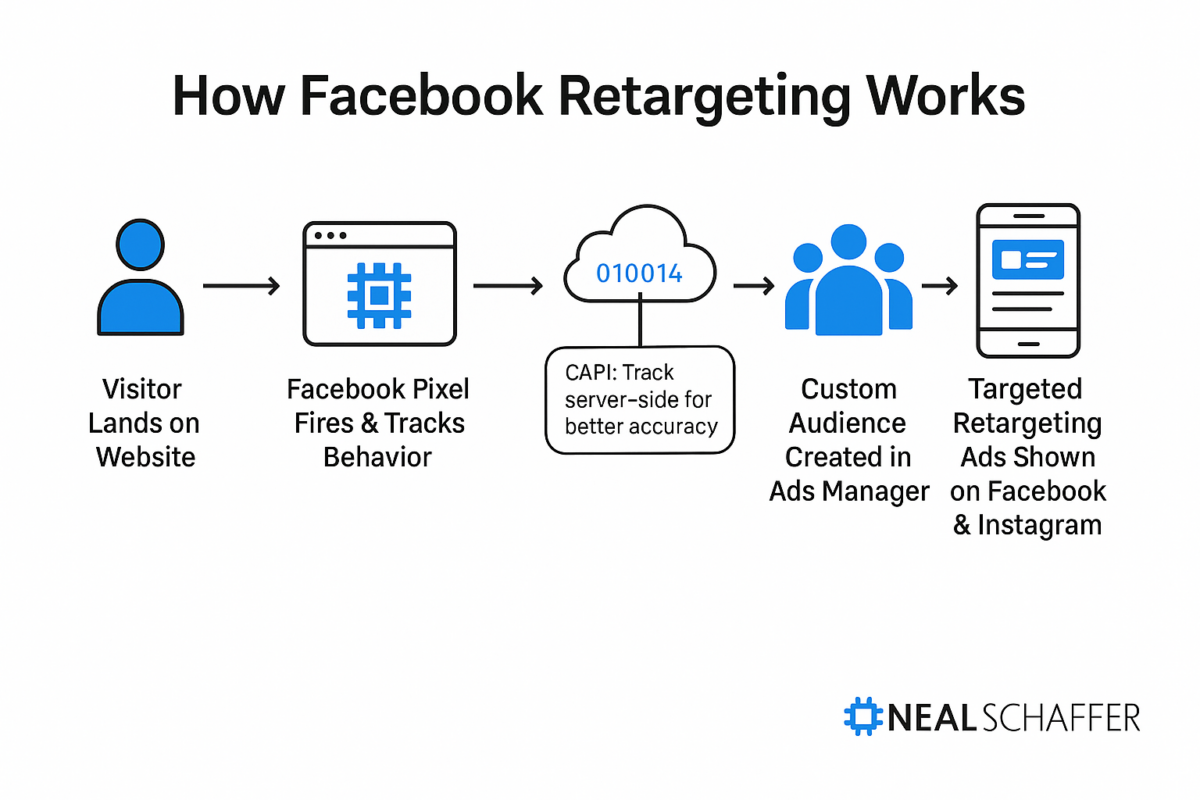
It’s worth noting that with today’s privacy updates (like iOS changes), the Meta Pixel alone doesn’t always give you complete tracking data. That’s why Facebook now recommends adding the Conversions API, which sends conversion event data directly from your server back to Facebook.
Using both together ensures you capture as much data as possible — making your retargeting campaigns more accurate and cost-effective.
Pixel-Based Retargeting vs. List-Based Retargeting
Finally, remember there are two main ways to build your retargeting audiences:
- Pixel-based: Uses the Pixel or CAPI to track website actions automatically.
- List-based: Uses email lists you upload manually. Great for re-engaging subscribers or customers who already know your brand.
Both have pros and cons — but for most marketers, pixel-based (plus CAPI) gives you the best scale and automation.
How to Set Up Facebook Retargeting Ads
Once you understand how retargeting works, it’s time to put it into action. Follow these updated steps to build a high-converting Facebook retargeting campaign in 2025.
The Meta Pixel (formerly known as the Facebook Pixel) is a small code snippet added to your website that tracks visitor behavior. The Conversions API can track similar data from your server, which is more reliable in today’s privacy-restricted environment (thanks to iOS 14.5+).
Learn how to install the Meta Pixel here.
Note that if you are a WordPress user you can make use of the Facebook for WordPress plugin which will walk you through this process.
 Source
SourceStep 2: Create Facebook Custom Audiences
Log in to your Facebook Ads Manager and select Audiences.
Overwhelmed by Digital Marketing?
Just released: my new book to help small businesses, entrepreneurs, and marketers master digital marketing in today’s digital-first world.
Drawing on my Fractional CMO experience, Digital Threads simplifies complex strategies into clear, actionable steps for success.
Transform your business today—grab your copy! Click the cover or button below to buy on Amazon.
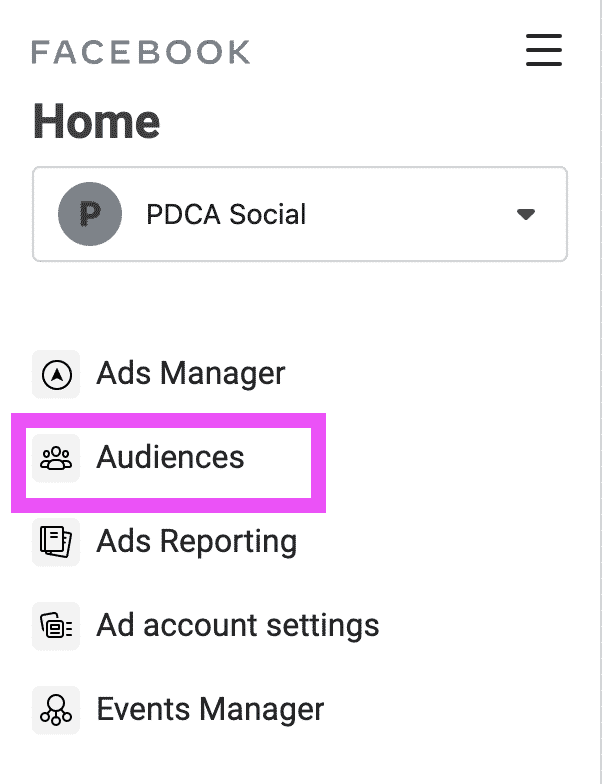
Click on Create Audience and select Custom Audiences.

Now select an option for your custom audience source:

Finally, the next screen is where you can customize your target audience:
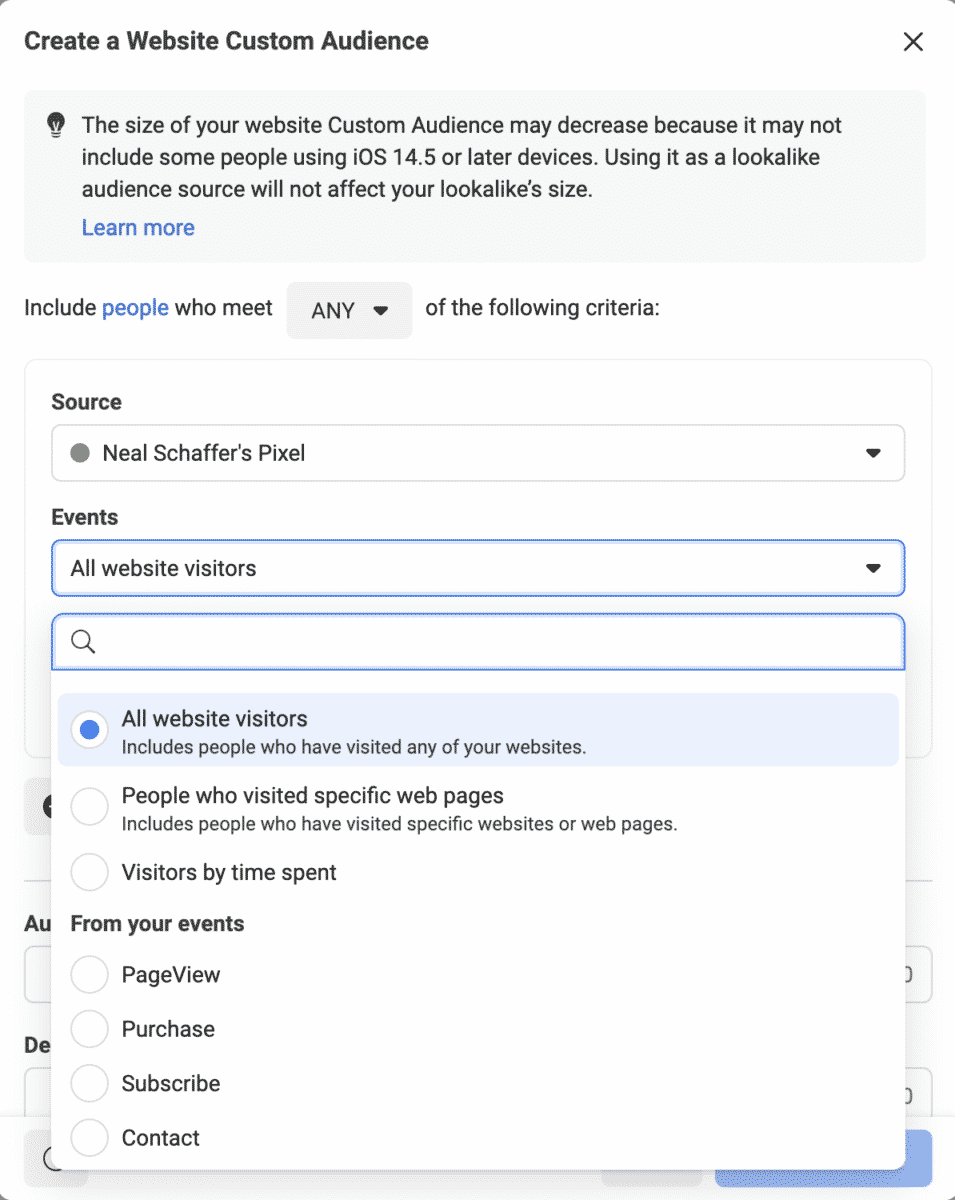
Here, you can build segmented groups like:
- People who visited your website in the last 30 days
- Users who added to cart but didn’t purchase
- Leads from your CRM or email list
- Video viewers who watched at least 50% of a specific video
- People who engaged with your Instagram profile in the last 90 days
- Facebook or Instagram event RSVPs
You can also exclude certain audiences, like users who have already purchased.
Step 3: Launch a Retargeting Campaign
Create a campaign and select a Custom Audience in the ad set level. Be sure your copy and creative match the intent of that target audience. For example:
- For cart abandoners, remind them what they left behind with a discount
- For past purchasers, offer a cross-sell or upsell
- For video viewers, show testimonials or limited-time offers
- For leads, offer case studies or demos
8 High-Impact Facebook Retargeting Campaign Types
Retargeting isn’t one-size-fits-all. The most effective ad campaigns are tailored to user behavior and intent—whether someone viewed a product, watched a video, or abandoned their cart—so you can meet them with the right message at the right time. You can also match these types with whatever specific marketing goal you have at the time.
1. Cart Abandonment Campaigns
When someone adds a product to their cart but leaves without buying, retarget them with an ad that shows the product they were interested in.
2. Product View Retargeting
These users browsed specific product pages but didn’t take further action. Show them that product again—or offer social proof or a time-sensitive deal.
Example: Salt & Stone retargeted customers who purchased deodorant with a complementary product (Body Mist), increasing customer LTV.
3. Content Retargeting
Retarget users who engaged with blog posts, guides, or videos with the next step in your funnel (like signing up for a webinar or downloading a lead magnet).
Example: ClickUp ran Facebook ads targeting users who downloaded a productivity guide, then retargeted them with a follow-up offer to try their team management software.
4. App Engagement Retargeting
Encourage app users who dropped off to re-engage.
5. Cross-Sell or Upsell Ads
Show new products to customers who have already made a purchase. Tailor the offer based on their previous purchase history.
Example: Ridge Wallet found that when they applied 30% of their Facebook Ads budget to retargeting past buyers, they ended up with a 48% lower cost per conversion and 71% increase in ROAS.
6. Loyalty Campaigns
Target your most loyal customers with early access or exclusive offers.
7. Event Retargeting
For webinars, product launches, or limited-time promotions, retarget users who clicked “Interested” but didn’t register or purchase.
8. Lead Nurturing Campaigns
Retarget people who have signed up for a lead magnet or filled out a form but haven’t taken further action. Serve them more information, testimonials, or a demo offer to move them down the funnel.
How Much Should You Spend on Retargeting?
Because retargeting audiences are smaller, your budget should reflect that. A good rule of thumb is to allocate 10–20% of your total Facebook Ads budget to retargeting.
If you’re spending $100 per day on Facebook Ads:
- $10–15 could go to cart abandonment ads
- $5 to loyalty and cross-sell campaigns
- $5 to video viewers and content downloaders
If you’re scaling, increase proportionally. Retargeting should drive 2–5x ROAS when executed correctly.
Retargeting Best Practices for 2025
Retargeting has become more nuanced in 2025, with changes to privacy, attribution, and user behavior across platforms. To keep your campaigns effective and cost-efficient, follow these proven best practices:
Segment Your Audiences
Don’t treat all past visitors the same. Break out your audiences based on key behavior signals like website traffic, product views, cart activity, time spent on site, video watch time, or engagement levels. This allows you to tailor messaging through greater personalization and show the right offer at the right time.
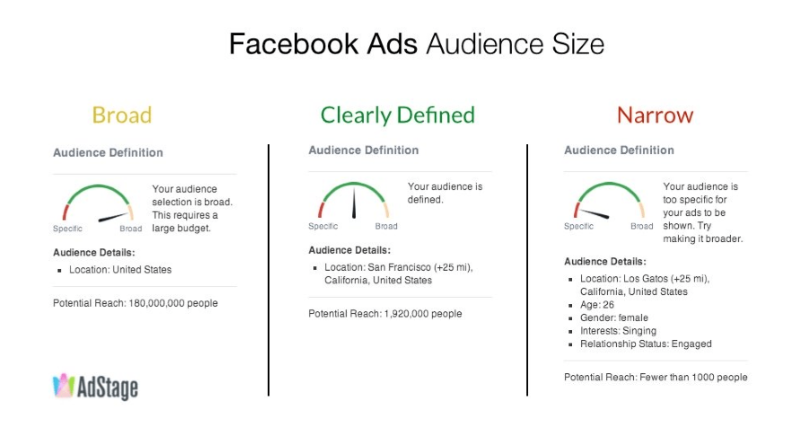 Source
SourceUse Dynamic Product Ads (DPAs)
For eCommerce businesses, Dynamic retargeting ads automatically show products with the most relevance to users based on their browsing history or cart behavior. You don’t have to manually create new ads for every product—Facebook pulls in images, prices, and descriptions directly from your Catalog Sales product feed to personalize each ad.
Refresh Your Creatives Often
Retargeting audiences are typically smaller and more targeted, so repeated exposure to the same creative can quickly lead to ad fatigue. Refresh your creatives—both images and copy—every 2 to 3 weeks to maintain performance. Test different formats like Facebook dynamic ads, carousels, videos, and user-generated content.
Offer Incentives
A gentle nudge like 10% off, free shipping, or a bonus gift can dramatically improve retargeting conversion rates. Use time-sensitive offers to create urgency, especially around sales periods like Black Friday, but be cautious not to train your audience to expect constant discounts. Limited-use promo codes and tiered incentives can help balance urgency with profitability.
Match the Ad to the Funnel Stage
Tailor your creative and messaging based on where the user is in their journey. For top-of-funnel viewers (e.g., someone who watched a video), use content that educates or builds trust like testimonials or case studies. For bottom-funnel users (e.g., cart abandoners), use urgency-driven CTAs, countdown timers, or product benefits.
Exclude Converted Users
Always set up exclusion audiences in the Facebook Business Manager to prevent ads from showing to users who have already taken your desired action, whether it’s a purchase, signup, or download. This reduces ad waste and avoids the risk of irritating loyal customers who already converted.
Set Frequency Caps
Limit how often users see your retargeting ads to avoid overexposure. A good benchmark is 3–5 impressions per user within a 7-day period. Monitor metrics like CTR, CPM, and conversion rate—if performance drops while frequency rises, it’s time to update your creative or adjust targeting.
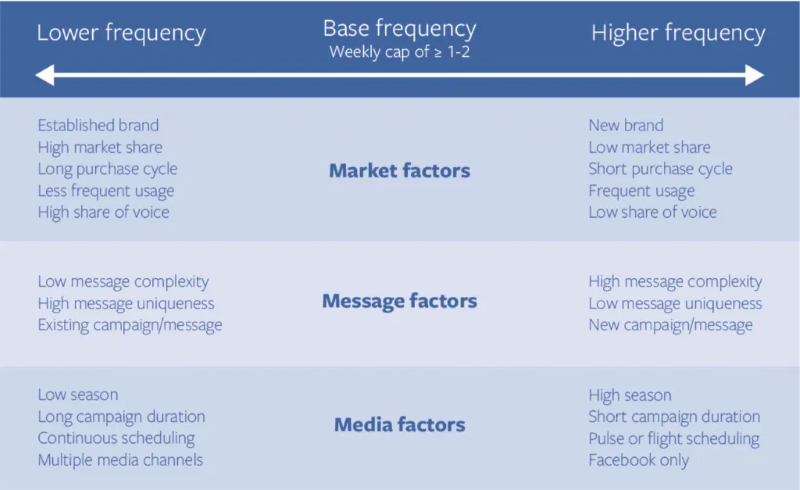 Source
SourceUse Lookalike Audiences Based on Retargeting Data
Once you identify a high-converting retargeting segment—like cart abandoners or email subscribers—use it to create audience lookalikes. Start with 1% similarity for the most accurate match and expand to 2% or 3% if you want to scale. This lets you reach new users who share traits with your best leads.
Choosing the right tools can streamline your retargeting workflow, improve tracking accuracy, and drive better results. Here are essential options to consider for Facebook Ads retargeting:
Meta Pixel: Tracks user actions on your website such as page views, purchases, and sign-ups, allowing you to create detailed retargeting audiences based on specific behaviors using pixel-based retargeting.
Conversions API: A server-side tracking tool that sends data directly from your server to Facebook, making it more resilient to browser changes and iOS privacy updates while improving attribution accuracy.
Madgicx: An AI-powered platform for Meta advertisers that provides pre-built retargeting audiences, automated optimization, creative testing, and performance analytics in one dashboard.
Birch (formerly Revealbot) or AdEspresso: Automation and optimization tools that help scale Facebook campaigns through rules-based bidding, A/B testing, budget adjustments, and cross-channel reporting.
Google Analytics 4: Offers additional insights on user journeys and multi-touch attribution, which can be used to refine Facebook audience strategies and identify where retargeting fits within your broader funnel.
Facebook Creative Hub: A built-in visual tool to mock up, test, and preview Facebook ad formats and ad placements before launching, allowing your team to collaborate on high-performing creatives using a dropdown interface.
Each of these tools brings a specific strength to your stack, whether it’s audience precision, better measurement, or campaign efficiency. Using them together gives you an edge in building smarter, more scalable retargeting efforts.
Further Reading: 15 AI Tools That Will Transform Your Facebook Ads Strategy
Common Mistakes to Avoid
- Over-segmentation: Creating too many small, narrowly defined audiences can restrict your campaign’s reach and impact. When your audience becomes too limited, Facebook’s algorithm struggles to deliver ads efficiently, which may result in higher costs and fewer chances at conversion. Instead, aim for broader groupings based on shared intent or sales funnel stage.
- Not testing creatives: Relying on a single ad image or message is risky. What works for one segment may not work for another. A/B testing your visuals and copy can significantly improve performance by helping you learn what resonates with each group. You should consistently refresh headlines, visuals, and CTAs to keep your game strong.
- No exclusions: Failing to exclude people who have already converted leads to wasted ad spend and can also damage the user experience. You risk annoying happy customers with irrelevant ads instead of focusing on new prospects. Use exclusion lists to prevent unnecessary impressions.
- Same ad for all audiences: Not all users are at the same stage in the retargeting funnel. Someone who abandoned a cart needs a different message than someone who just liked your brand awareness ads. Segment your campaigns by behavior and deliver tailored creative to match intent. For example, use urgency-based messages for bottom-funnel users and educational content for top-funnel ones.
- Ignoring frequency: Bombarding your audience with the same ad over and over can lead to ad fatigue, causing lower engagement and higher CPMs. Monitor your frequency and rotate ad creatives regularly to keep content fresh.
- Poor landing page alignment: If your ad promotes a specific offer but the landing page is generic or mismatched, you’ll lose trust and conversions. Always align your messaging from ad to landing page for a seamless Internet journey. Use consistent design, tone, and CTA language to reduce drop-off.
- Ignoring mobile optimization: With the majority of Facebook users browsing via mobile, your landing pages must load quickly, display well on all devices, and include simple navigation and clear CTAs. Poor mobile experiences drive high bounce rates and lost revenue.
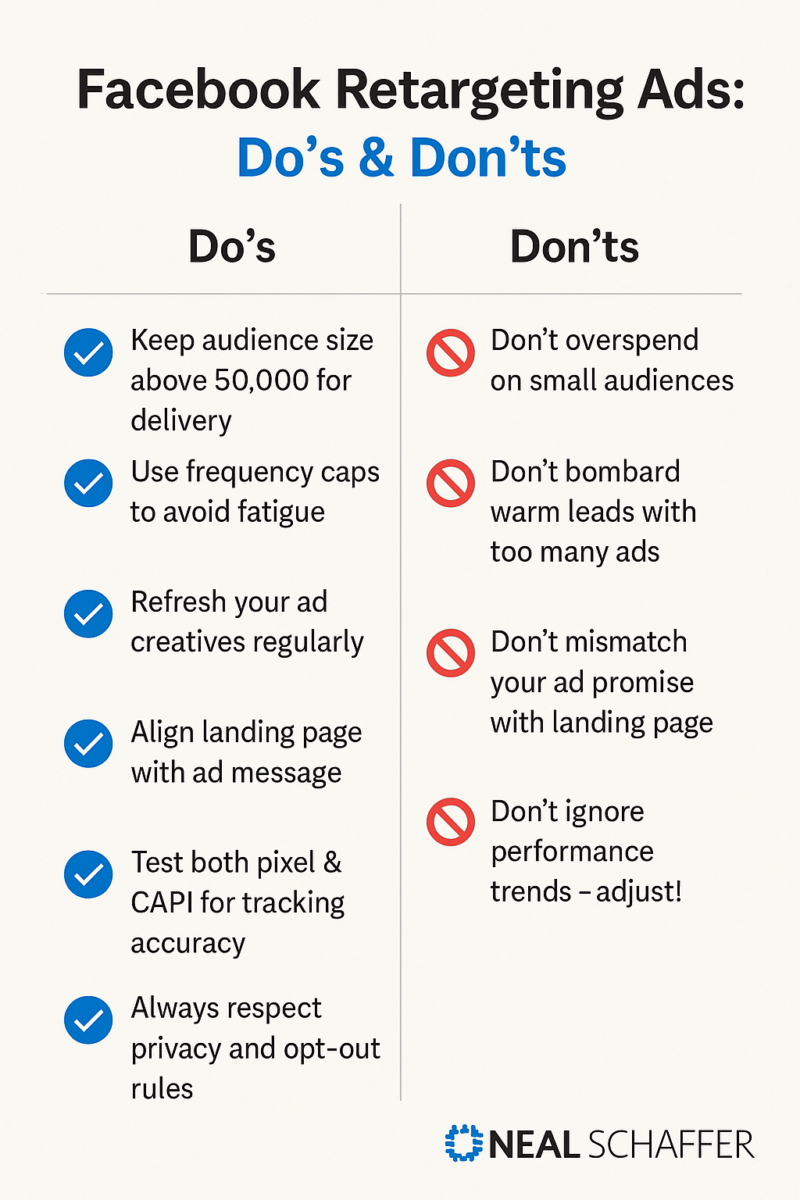
Further Reading: Facebook Ad Not Delivering? Here’s How to Fix Common Issues
Conclusion: Retargeting Is Essential in 2025
In a digital landscape where attention is short and competition is fierce, Facebook Ads retargeting gives you a second (or third) chance to win the customer.
From dynamic ads to loyalty re-engagement and event follow-ups, the possibilities are nearly endless. When executed correctly, retargeting campaigns not only improve conversions—they also maximize your ROI and reduce wasted ad spend.
Start by installing the Pixel, building Custom Audiences, and launching a small test. Then optimize from there.
Retargeting isn’t a nice-to-have anymore. It’s a must-have.
For more insights on digital advertising, check out my guide to 15 powerful and effective Facebook Ads strategies.
Actionable advice for your digital / content / influencer / social media marketing.
Join 13,000+ smart professionals who subscribe to my regular updates.